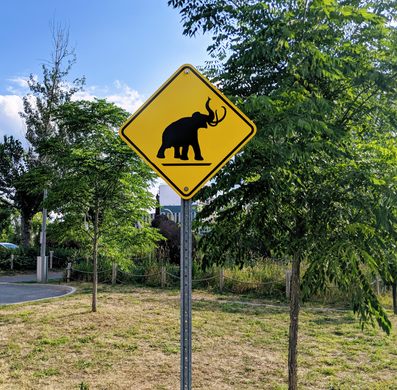AO Edited
Dinosaur Crossing Signs and Statues
These prehistoric replicas were based on actual skeletal remains.
These signs, one depicting a woolly mammoth and the other a Chasmosaurus irvinensis, are a playful homage to the Canadian Museum of Nature’s Centre for Arctic Knowledge and Exploration. Accompanying each signpost are fully fleshed-out replicas of these creatures that provide a glimpse into life during the Late Cretaceous Period and the last Ice Age.
The trio of mammoths, two adults and one baby, take inspiration from published scientific research and fossils, including the mummified remains of Dima, a woolly mammoth calf found in Siberia. They were also based on the skeletal remains of fully-grown specimens found in the Yukon and Alaska. The mammoths “live” peacefully on the Landscapes of Canada Gardens, which includes vegetation reminiscent of the mammoth steppe.
The Chasmosaurus irvinensis, one adult and one child, commemorate a breakthrough discovery made by museum scientists in the late 1990s. This revelation came during a debate among paleontologists when discussing the legs of horned, upright-walking dinosaurs.
While examining a particular specimen in the museum’s fossil collection, then thought to belong to Chasmosaurus, researchers opened the plaster encasement where they assumed the legs were and discovered the skull instead. This led to further examination and the uncovering of large openings in the frill of the skull. These physical anomalies were signs of a new species.
Know Before You Go
The signs and replicas are located on the grounds of the Canadian Museum of Nature.
The mammoth family and sign are located past the intersection of McLeod and Metcalfe streets (45°24'46.1"N 75°41'23.3"W).
The Chasmosaurus irvinensis replica and accompanying sign can be found on Metcalfe Street, straddling Argyle and McLeod (45°24'47.9"N 75°41'13.7"W).



















Follow us on Twitter to get the latest on the world's hidden wonders.
Like us on Facebook to get the latest on the world's hidden wonders.
Follow us on Twitter Like us on Facebook